主谓一致用法详细讲解40例
中考英语总复习之主谓一致-详解与练习
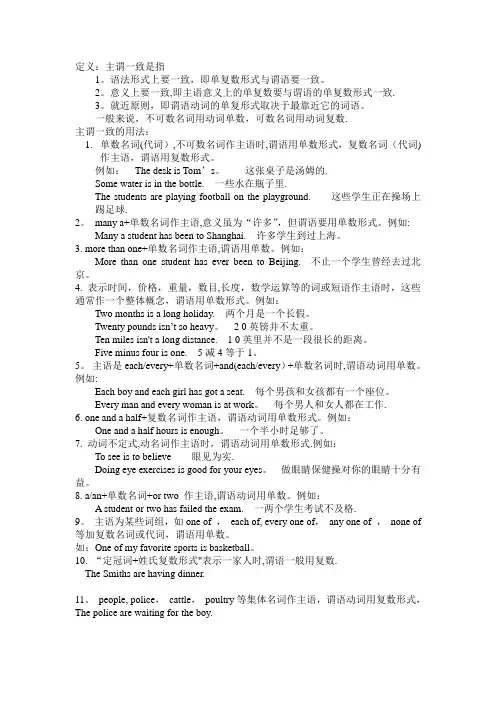
定义:主谓一致是指1。
语法形式上要一致,即单复数形式与谓语要一致。
2。
意义上要一致,即主语意义上的单复数要与谓语的单复数形式一致.3。
就近原则,即谓语动词的单复形式取决于最靠近它的词语。
一般来说,不可数名词用动词单数,可数名词用动词复数.主谓一致的用法:1.单数名词(代词),不可数名词作主语时,谓语用单数形式,复数名词(代词)作主语,谓语用复数形式。
例如:The desk is Tom’s。
这张桌子是汤姆的.Some water is in the bottle. 一些水在瓶子里.The students are playing football on the playground. 这些学生正在操场上踢足球.2。
many a+单数名词作主语,意义虽为“许多”,但谓语要用单数形式。
例如: Many a student has been to Shanghai. 许多学生到过上海。
3. more than one+单数名词作主语,谓语用单数。
例如:More than one student has ever been to Beijing. 不止一个学生曾经去过北京。
4. 表示时间,价格,重量,数目,长度,数学运算等的词或短语作主语时,这些通常作一个整体概念,谓语用单数形式。
例如:Two months is a long holiday. 两个月是一个长假。
Twenty pounds isn’t so heavy。
2 0英镑并不太重。
Ten miles isn't a long distance. 1 0英里并不是一段很长的距离。
Five minus four is one. 5减4等于1。
5。
主语是each/every+单数名词+and(each/every)+单数名词时,谓语动词用单数。
例如:Each boy and each girl has got a seat. 每个男孩和女孩都有一个座位。
主谓一致用法详细讲解40例
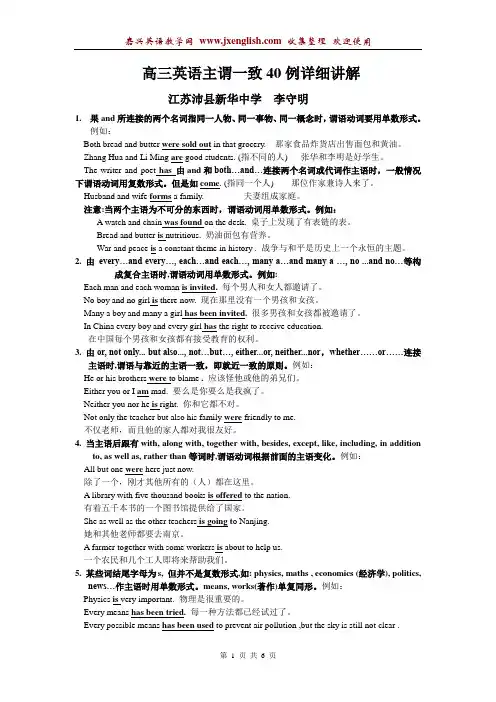
高三英语主谓一致40例详细讲解江苏沛县新华中学李守明1.果and所连接的两个名词指同一人物、同一事物、同一概念时,谓语动词要用单数形式。
例如:Both bread and butter were sold out in that grocery. 那家食品炸货店出售面包和黄油。
Zhang Hua and Li Ming are good students. (指不同的人) 张华和李明是好学生。
The writer and poet has 由and和both…and…连接两个名词或代词作主语时,一般情况下谓语动词用复数形式。
但是如come. (指同一个人) 那位作家兼诗人来了。
Husband and wife forms a family. 夫妻组成家庭。
注意:当两个主语为不可分的东西时,谓语动词用单数形式。
例如:A watch and chain was found on the desk. 桌子上发现了有表链的表。
Bread and butter is nutritious. 奶油面包有营养。
War and peace is a constant theme in history . 战争与和平是历史上一个永恒的主题。
2. 由every…and every…, each…and each…, many a…and many a …, no ...and no…等构成复合主语时,谓语动词用单数形式。
例如:Each man and each woman is invited.每个男人和女人都邀请了。
No boy and no girl is there now. 现在那里没有一个男孩和女孩。
Many a boy and many a girl has been invited.很多男孩和女孩都被邀请了。
In China every boy and every girl has the right to receive education.在中国每个男孩和女孩都有接受教育的权利。
主谓一致的基本规则及常见例子
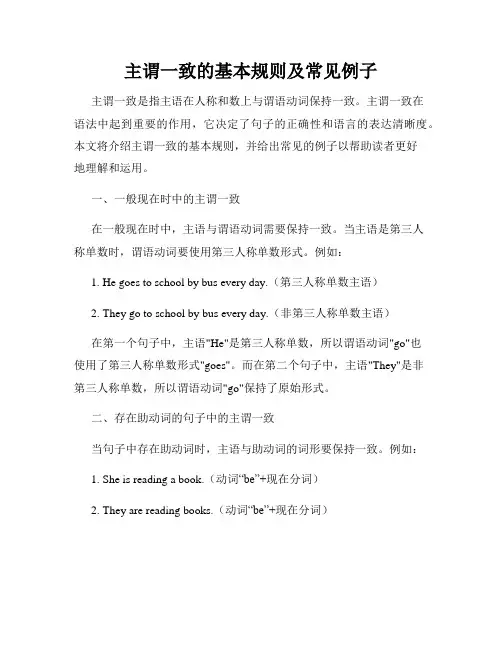
主谓一致的基本规则及常见例子主谓一致是指主语在人称和数上与谓语动词保持一致。
主谓一致在语法中起到重要的作用,它决定了句子的正确性和语言的表达清晰度。
本文将介绍主谓一致的基本规则,并给出常见的例子以帮助读者更好地理解和运用。
一、一般现在时中的主谓一致在一般现在时中,主语与谓语动词需要保持一致。
当主语是第三人称单数时,谓语动词要使用第三人称单数形式。
例如:1. He goes to school by bus every day.(第三人称单数主语)2. They go to school by bus every day.(非第三人称单数主语)在第一个句子中,主语"He"是第三人称单数,所以谓语动词"go"也使用了第三人称单数形式"goes"。
而在第二个句子中,主语"They"是非第三人称单数,所以谓语动词"go"保持了原始形式。
二、存在助动词的句子中的主谓一致当句子中存在助动词时,主语与助动词的词形要保持一致。
例如:1. She is reading a book.(动词“be”+现在分词)2. They are reading books.(动词“be”+现在分词)在第一个句子中,主语“She”是第三人称单数,所以助动词“is”也使用了第三人称单数形式。
而在第二个句子中,主语“They”是非第三人称单数,所以助动词“are”保持了原始形式。
三、特殊情况下的主谓一致1. 连接词“either...or...”或“neither...nor...”连接两个主语时,谓语动词要与靠近的主语保持一致。
例如:Neither John nor his friends are going to the party.(“neither...nor...”连接两个主语,谓语动词与靠近的主语"friends"保持一致)2. 当主语为复数形式,但表示整体单一概念时,谓语动词要使用单数形式。
高一语法:主谓一致

汉语很难学。
Chinese are very hospitable.
中国人非常好客。
三、谓语动词用单复数均可
3.以-ics 结尾的词作主语时,表示学科时,谓语动 词用单数形式;表示特定事物时,谓语动词用复 数形式。 例如: Statistics is a branch of mathematics.
雅典是希腊的首都。
Good news comes.
好消息来了。
一、谓语动词用单数
8.单个的不定式短语,动名词或名词性从句做主语时,谓 语动词用单数形式。 例如: To see is to believe.
眼见为实。
Reading is important in second language acquisition.
我校有一百多名学生来自南方。
一、谓语动词用单数
5.由each …and each…,every…and every…,many a …and many a …,no…and no…做主语时,谓语动 词用单数形式。 例如: Every boy and every girl was asked to show their identity card.
老年人受到年轻人的尊敬。
The accused is involved in a case.
被告涉嫌了这起案件。
三、谓语动词用单复数均可
5.用and连接的两个名词作主语,表示同一个人或 事物时,谓语动词用单数;表示不同的人或事物 时,谓语动词用复数形式。 例如: The singer and dancer is from Dunhuang.
李明是从那个大学毕业的最聪明的学生。
四、主谓一致的特殊结构
5.主语后带有as well as、along with、together with、 rather than、but、except等引起的介词短语时,谓语动 词的单复数和主语的单复数相一致。 例如: A doctor together with two nurses , has been sent to that poor village to help sick people.
高考英语主谓一致用法全汇总
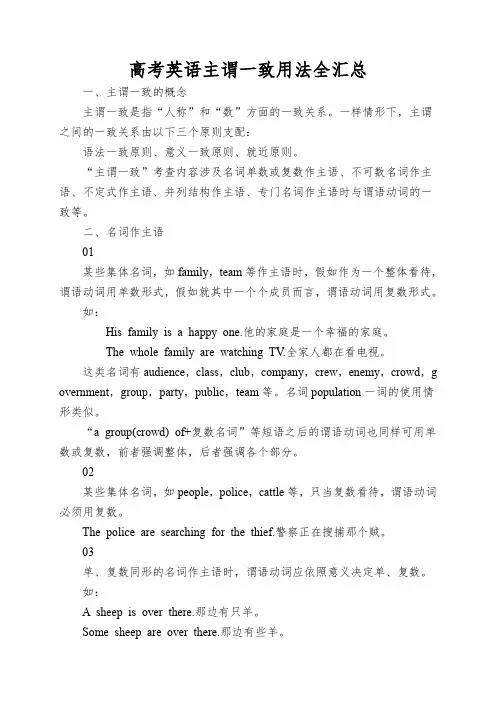
高考英语主谓一致用法全汇总一、主谓一致的概念主谓一致是指“人称”和“数”方面的一致关系。
一样情形下,主谓之间的一致关系由以下三个原则支配:语法一致原则、意义一致原则、就近原则。
“主谓一致”考查内容涉及名词单数或复数作主语、不可数名词作主语、不定式作主语、并列结构作主语、专门名词作主语时与谓语动词的一致等。
二、名词作主语01某些集体名词,如family,team等作主语时,假如作为一个整体看待,谓语动词用单数形式,假如就其中一个个成员而言,谓语动词用复数形式。
如:His family is a happy one.他的家庭是一个幸福的家庭。
The whole family are watching TV.全家人都在看电视。
这类名词有audience,class,club,company,crew,enemy,crowd,g overnment,group,party,public,team等。
名词population一词的使用情形类似。
“a group(crowd) of+复数名词”等短语之后的谓语动词也同样可用单数或复数,前者强调整体,后者强调各个部分。
02某些集体名词,如people,police,cattle等,只当复数看待,谓语动词必须用复数。
The police are searching for the thief.警察正在搜捕那个贼。
03单、复数同形的名词作主语时,谓语动词应依照意义决定单、复数。
如:A sheep is over there.那边有只羊。
Some sheep are over there.那边有些羊。
04名词所有格之后的名词被省略,这种情形一样只指商店、工厂、住宅等,作主语时,动词一样用单数。
如:The doctor’s is across the street.诊所在街道的对面。
My uncle’s is not far from here.我叔叔家离这儿不远。
常见的省略名词有the baker’s,the barber’s,the carpenter’s,the Zhang’s等。
(完整版)主谓一致用法总结
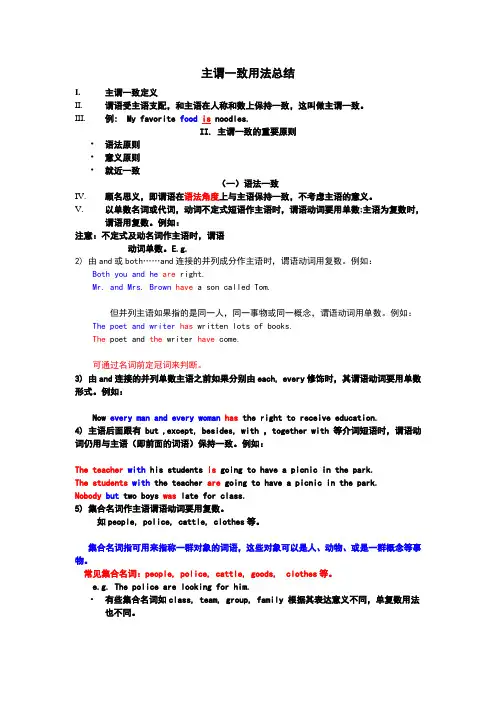
主谓一致用法总结I.主谓一致定义II.谓语受主语支配,和主语在人称和数上保持一致,这叫做主谓一致。
III.例: My favorite food is noodles.II. 主谓一致的重要原则•语法原则•意义原则•就近一致(一)语法一致IV.顾名思义,即谓语在语法角度上与主语保持一致,不考虑主语的意义。
V.以单数名词或代词,动词不定式短语作主语时,谓语动词要用单数;主语为复数时,谓语用复数。
例如:注意:不定式及动名词作主语时,谓语动词单数。
E.g.2) 由and或both……and连接的并列成分作主语时,谓语动词用复数。
例如:Both you and he are right.Mr. and Mrs. Brown have a son called Tom.但并列主语如果指的是同一人,同一事物或同一概念,谓语动词用单数。
例如:The poet and writer has written lots of books.The poet and the writer have come.可通过名词前定冠词来判断。
3) 由and连接的并列单数主语之前如果分别由each, every修饰时,其谓语动词要用单数形式。
例如:Now every man and every woman has the right to receive education.4) 主语后面跟有 but ,except, besides, with ,together with 等介词短语时,谓语动词仍用与主语(即前面的词语)保持一致。
例如:The teacher with his students is going to have a picnic in the park.The students with the teacher are going to have a picnic in the park.Nobody but two boys was late for class.5) 集合名词作主语谓语动词要用复数。
主谓一致详细讲解
主谓一致主谓一致指的是句子的主语和谓语在人称和数上要保持一致,通常有以下三种原则:语法一致原则主语和谓语通常是在语法形式上取得一致,即主语是单数形式,谓语动词用单数形式;主语是复数形式,谓语动词用复数形式。
1. 单数主语搭配单数谓语:如果主语是可数名词单数、不可数名词或者第三人称单数代词(如he、she、it 等),谓语动词要用相应的单数形式。
The dog runs fast. 主语“dog” 是可数名词单数,谓语动词“runs” 采用了第三人称单数形式。
Water is essential for life. water为不可数名词,谓语动词“is” 是单数形式。
2. 复数主语搭配复数谓语:当主语是可数名词复数时,谓语动词需使用复数形式。
The trees are green in spring. trees为可数名词复数,谓语动词“are” 是复数形式。
3.当and 或both...and..连接两个或两个以上名词作主语时,谓语动词用复数形式。
Tom and Mike are good friends.汤姆和迈克是好朋友。
Both Lucy and Lily are students.露西和莉莉都是学生。
4. 不定代词either, neither, each one, the other, another, anybody , anyone , anything , someone , somebody , something, everyone,everybody ,everything , nobody , no one , nothing等作主语时,谓语动词用单数形式。
Everyone is ready for the sports meeting.大家都在为运动会做准备。
5. 由each , each...and each..., every ...and every...作主语时,谓语动词用单数形式。
主谓一致-讲解++练习(全)
主谓一致的用法及专项练习题一、主谓一致三原则主谓一致是指谓语动词与主语在人称和数上保持一致,主谓一致必须遵循三原则:语法一致原则,意义一致原则,就近一致原则。
1、语法一致原则:指主语是单数形式,谓语动词用单数形式,主语是复数形式,谓语也用复数形式。
Tom is a good student。
汤姆是个好学生。
They often play football on the playground. 他们经常在操场上踢足球。
2、意义一致:指主语形式上为单数,但意义为复数,因此谓语动词用复数形式;或主语形式上为复数,但表示单数意义,这是谓语动词用单数形式。
My family are having lunch now。
我们一家人现在正吃午饭。
Twenty dollars is too expensive for the book。
这本书20美元太贵了。
3、就近一致:指谓语动词用单数形式还是用复数形式,取决于最靠近他的主语。
例如:Not only the teacher but also his students like playing football.不仅老师喜欢踢足球,而且他的学生也喜欢踢足球。
There is a pen and some books on the desk。
课桌上有一支钢笔和一些书。
二、主谓一致常考题型1、单数名词(代词)/不可数名词作主语时,谓语用单数形式;复数名词(代词)作主语,谓语用复数形式。
The desk is Tom’s. 这张桌子是汤姆的。
Some water is in the bottle. 一些水在瓶子里。
The students are playing football on the playground。
这些学生正在操场上踢足球。
2、“a great/ good many+复数名词”作主语时,谓语动词用复数。
但“many a+名词”作主语,意义虽为“许多",但谓语要用单数形式.Many a student has been to Shanghai. 许多学生到过上海。
高中英语主谓一致的用法讲解
主谓一致的用法讲解一、形式一致原则即主语为单数,谓语用单数,主语为复数,谓语也用复数. 以下为注意事项:1. 单数主语即使后面带有with,along with,together with,like,but,except,besides,as well as,no less than,rather than,including,in addition to 引导的短语,谓语动词仍用单数.如: Air as well as water is matter. 空气和水都是物质.No one except two servants was late for the dinner.除了两个仆人外,没有一个人迟来用餐。
2. 用and连接的并列主语,如果主语是同一个人,同一事,同一概念,谓语动词用单数,否则用复数. 如:The poet and writer has come. 那位诗人兼作家来了.A hammer and a saw are useful tools. 锤子和锯都是有用的工具.用and连接的成对名词习惯上被看成是一个整体,如:bread and butter,knife and fork等作主语时,谓语动词用单数。
3. 不定式,动名词,或从句作主语时,谓语动词用单数. 如:Serving the people is my great happiness.为人民服务是我最大的幸福.When we’ll go out for an outing has been decided.我们什么时候出去郊游已决定了。
4. 用连接的并列主语被each,every 或no修饰时,谓语动词用单数. Every boy and every girl likes to go swimming. 每个男孩和每个女孩都喜欢去游泳.No teacher and no student was absent from the meeting. 没有老师也没有学生开会缺席.Each man and (each)woman is asked to help. 每个男人和每个女人都被请去帮忙。
主谓一致的用法与例句解析
主谓一致的用法与例句解析主谓一致是英语语法中非常重要的一个概念,指的是主语和谓语在人称和数上要保持一致。
主谓一致的正确运用可以使句子更加准确、清晰和易于理解。
本文将介绍主谓一致的用法,并通过例句解析来帮助读者更好地理解和掌握。
一、基本规则1. 单数主语与单数谓语动词一致,复数主语与复数谓语动词一致:- The cat eats fish.(猫吃鱼。
)- The boys play football.(男孩们踢足球。
)2. 不可数名词作主语时,谓语动词用单数形式:- Water is essential for life.(水对生命是必不可少的。
)- This news is very shocking.(这个消息非常震惊。
)3. 用and连接的两个或多个主语,如果表示同一事物或同一人,则谓语动词用单数形式;如果表示不同事物或不同人,则谓语动词用复数形式:- Bread and butter is his favorite breakfast.(面包和黄油是他最喜欢的早餐。
)- Tom and Jack are good friends.(汤姆和杰克是好朋友。
)4. 以every, each, either, neither等为主语的句子,谓语动词用单数形式:- Every child needs love and care.(每个孩子都需要爱和关心。
)- Neither of them is available tomorrow.(他们俩明天都不可用。
)二、特殊情况1. 多个名词作主语,其中有一个是表示数量或距离的词时,谓语动词根据量词或距离词的数来决定单复数:- Five kilometers is a long way to walk.(五公里是一个很长的路程。
)- Three cups of coffee are enough for me.(对我来说,三杯咖啡就足够了。
)2. 在There be句型中,谓语动词的单复数与后面的主语一致:- There is a book on the table.(桌子上有一本书。
- 1、下载文档前请自行甄别文档内容的完整性,平台不提供额外的编辑、内容补充、找答案等附加服务。
- 2、"仅部分预览"的文档,不可在线预览部分如存在完整性等问题,可反馈申请退款(可完整预览的文档不适用该条件!)。
- 3、如文档侵犯您的权益,请联系客服反馈,我们会尽快为您处理(人工客服工作时间:9:00-18:30)。
主谓一致详细讲解1.由and所连接的两个名词指同一人物、同一事物、同一概念时,谓语动词要用单数形式。
例如:Both bread and butter were sold out in that grocery.Zhang Hua and Li Ming are good students.注意:当两个主语为不可分的东西时,谓语动词用单数形式。
例如:A watch and chain was found on the desk. Bread and butter is nutritious.When and where this took place is still unknown.注意:一身兼二职的情况:The writer and runner is attending the conference.2. 由every…and every…, each…and each…, many a…and many a …, no ...and no…等构成复合主语时,谓语动词用单数形式。
例如:Each man and each woman is invited.每个男人和女人都邀请了。
No boy and no girl is there now. 现在那里没有一个男孩和女孩。
Many a boy and many a girl has been invited.很多男孩和女孩都被邀请了。
In China every boy and every girl has the right to receive education.在中国每个男孩和女孩都有接受教育的权利。
3. 由or, not only... but also..., not…but…, either...or, neither...nor,whether……or……连接主语时,谓语与靠近的主语一致,即就近一致的原则。
例如:He or his brothers were to blame .Either you or I am mad. Are either you or I mad? Neither you nor he is right. Not only the teacher but also his family were friendly to me.4. 当主语后跟有with, along with, together with, besides, except, like, including, in additionto, as well as, rather than等词时,谓语动词根据前面的主语变化。
例如:All but one were here just now. A library with five thousand books is offered to the nation. She as well as the other teachers is going t o Nanjing.5. 某些词结尾字母为s, 但并不是复数形式,如: physics, maths , economics (经济学), politics,news…作主语时用单数形式。
means, works(著作)单复同形。
例如:Physics is very important. Every means has been tried.Every possible means has been used to prevent air pollution, but the sky is still not clear .6. 当一些由两部分构成的表示衣物或工具的名称作主语时, 谓语用复数形式, 如:trousers , shorts, shoes, glasses, goods, clothes, chopsticks, scissors. 如果这些词由a pair, piece, kind , type ,box + of 修饰,则用单数形式.例如:My trousers are white and his clothes are black. A pair of shoes is lying here. These kinds of glasses are popular.7.单复数同形的名词,如sheep, deer 等做主语时,应根据主语的单复数意义确定谓语动词的形式。
例如:A deer is over there. Some deer are over there .8.population做主语时,通常看作单数,若population前有分数、百分数修饰时,则句子谓语通常用复数。
例如:The population in China is very large and 80% of the population live in rural areas .9. 复数名词, 如: people, police, public ,crew ,cattle作主语时, 谓语动词用复数形式。
例如:The police like to help people. People are talking abou t the news ..The cattle are grazing in the fields .10. 集体名词, 如: family ,crowd ,class ,team ,audience ,committee ,club, group ,enemy ,population, government等, 如把它们当作整体看, 谓语动词用单数; 如把它们当作若干个体来看, 谓语动词用复数。
例如:Our family is very happy. My family are all football fans.11.表示某一国人或某一民族、种族的人的名词作主语时,谓语动词用复数。
例如:The Chinese were a highly civilized people long before the Europeans .12. 表示距离, 时间, 长度,价值, 金额, 重量等的词, 用复数形式时, 谓语动词一般用单数。
Two thousand dollars is a large sum. Two hours is enough.但是算式中表示数字的主语一般视为单数,谓语动词多用单数形式..例如:Five times six makes (make ) thirty . 5乘6等于30.Five plus /and five is / are ten . 5加5等于10 .Ten minus six leaves four . 10 减6 等于4 .Twenty-five divided by five equals five . 25除以5等于5 .13.“more than one+名词”作主语时,谓语动词用单数; “more than two, three ...+名词”作主语时,谓语动词用复数。
例如:More than one student is going to be a lawyer in the future .14. the + 形容词,表示一类人,谓语动词用复数;若the + 形容词,表示一类物,谓语动词用单数。
例如:The rich are for the decision but the poor are against it. The beautiful lives forever.15. 关系代词who, that, which等在定语从句中作主语时,其谓语动词的数应该与句中先行词的数一致。
例如:I, who am only a common worker, will retire in two years.但是one of +复数名词+从句,从句的谓语动词应用复数,而the ( only/very ) one of +复数名词+从句,从句的谓语动词应用单数。
例如:This is one of the most interesting questions that have been asked .Sarah is the only one of the girls who plays in the band .17.由what引导的主语从句,谓语动词一般用单数形式,但若从句谓语或从句后的表语是复数形式,则谓语动词用复数. 例如:What you said is quite to the point . What we need are qualified teachers .WhatIsay and think are no business of his .=What I say and what I thinkWhat I miss badly are those happy hours I spent together with them .22.在it引导的强调句中,who 或that 后的谓语动词在人称和数上应与前面被强调的名词或代词在人称和数上保持一致。
例如:It’s I who am to blame. It is you who are to blame.It is the people who / that are really powerful.25.由There ,Here引起的句子,主语又不止一个,其谓语动词通常和邻近的那个词保持一致。
例如:There is a knife and some apples here. Here are some envelopes and paper.26.在倒装句中,与后面的主语一致。
例如:South of the city is a large stadium. On the wall hang two large portraits.27.“分数或百分数+ of +名词”结构作主语时,谓语动词的单复数取决于其中的名词.例如:Three—fourths of the surface of the earth is sea. Two-thirds of the youth support the plan. 29. 代词none和neither 做主语时,有时作单数看待,有时作复数看待,主要根据说话人的意思来决定。
但是代表不可数名词时,只作单数。
neither 作形容词时与单数名词连用,谓语动词用单数形式。
例如:None of them has / have arrived yet.None of this money is mine. Neither of the students know / knows the answer.30.the number of +复数名词的中心词是短语中的名词,故谓语动词用复数形式;而“thenumber of +名词”的中心词是number,故谓语动词用单数形式。
